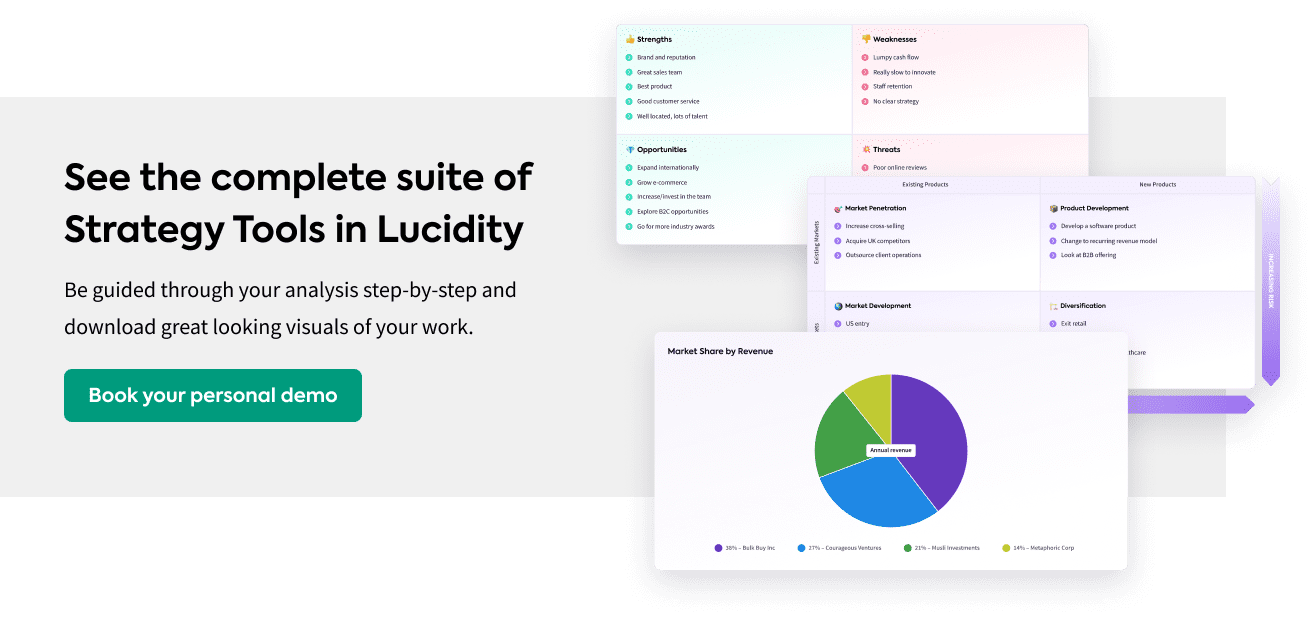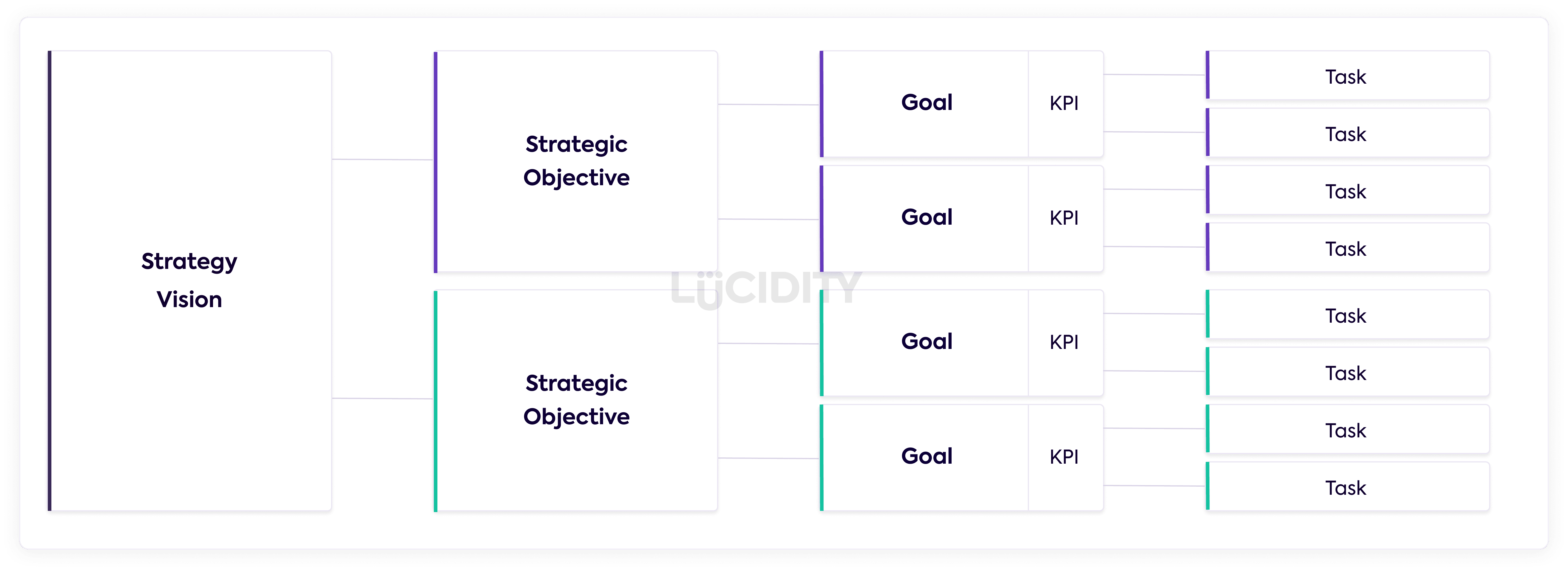Strategy is just where you want to get to and how you’re going to get there. Nothing more complicated than that, so a lot of difficulty around creating a strategy comes from knowing the right structure, steps and preparation to get it right.
In this article we’ll look at some of the preparation you should do, the structure you should follow, and some tools to help you.
Understand your marketplace
To formulate your strategy well you need to understand your market, the forces that impact your business, and the wider economic landscape. There are a lot of useful frameworks to help you get to a point of being able to make some key strategic decisions.
Picking your frameworks is a whole other article, but if this is your first time developing a strategy you can’t go wrong with three of the most common: SWOT, PESTLE and Five Forces.
Going through each of these tools will enable you to gain a better understanding of both the internal workings of your company and the external environment.
PESTLE:
A PESTLE Analysis is a framework for identifying the Political, Economic, Social, Technological, Legal and Environmental factors that could impact your business. It’s commonly presented as a six pillar structure and can be applied to any business in any industry. This structure allows you to easily view all of the key external factors influencing your business in one diagram.
Five Forces:
Five Forces is a framework to analysis and understand the forces that are shaping your competitive marketplace. It’s a framework to look at your industry not your company. It covers many areas such as the dynamics of the customers, the power of suppliers, the risk you’ll be substituted with a different product or service, the different direct competitors and the risk of new entry to the market.
SWOT Analysis:
A SWOT Analysis is a framework for identifying Strengths, Weaknesses, Opportunities and Threats. It is often presented a 2×2 matrix and can be applied to any business and industry, from non-profit charities through to large corporate entities. The structure of the grid means the top row looks at all internal issues, both positive and negative, while the bottom evaluates the external factors. Similarly, the left of the grid is positive, while the right of the grid is negative. A well thought-out SWOT will provide you with new opportunities to go for as well as ensuring threats to your business are mitigated or eliminated.
Use these frameworks to develop your key Strategic Objectives.
Read Corporate Strategy VS Business Strategy: What’s the Difference?
Ideally between 3-6 major outcomes you are trying to achieve as a business in this strategic plan. Some tips to help…
Use data well
If you’ve completed your market research, you’re going to have a lot of data. It might be lists of company strengths, market metrics around growth, the latest competitor activities, or a skills matrix for the team. This data is going to be key in understanding the decisions you can make.
The key element of data within your tools is make sure you’re making decisions based on the data and facts, try not to be subjective. If a market is in decline but there’s a great emotional connection to a historic product, you still need to acknowledge that market is in decline.
Look through your analysis in PESTLE, SWOT and Five Forces, and confirm that there are metrics or facts to back up each assumption.
Be bold and brave
It’s important to be bold and ambitious in your strategic thinking. You’re taking the business or department forward and so this isn’t the time for small operational or tactical discussions. These are big steps forward, large objectives, major strategic movements. Consider if a product is going to move into a new country, but don’t look at if you’re going to spend money revamping a web site.
Develop different strategic options
There are a number of different strategic options on how to approach a market, evaluate a few of them to compare and contrast which are likely to help you succeed. Draw on your market understanding to help reinforce certain strategic choices. You can use tools like the Strategy Clock to view different approaches.
Funding
You need to make sure you’re equipped financially to fund a particular strategy.
Your economic health and position should be considered when selecting which strategic option you pick. For example, if you’re in a difficult financial situation then it may not be possible to launch into a new market. If this is required, you would therefore need to obtain investment or funding as a key strategic objective.
Focus
Good strategy is as much about saying no to certain activities as it is about focusing on the right ones. Make sure you are ruthless in removing anything that is a distraction and not strategically moving you forward.
Go through the process of Start, Stop, Continue described in our Revenue Segmentation Guide and ensure your activities are aligned to your growth.
Evolve & Adapt
There can be a misconception that a company goes on a strategy offsite day, the management team play some games, often involving Lego or building bridges out of spaghetti, and the strategy is formed.
The reality is the market you operate in moves rapidly, and you need to be constantly evolving your strategy and reviewing your decisions. Reflect on your SWOT, PESTLE and Five Forces on a quarterly basis and examine your Strategic Objectives – are they still correct?
Open up your strategy, include frontline employees, customers, and experts. You will get better ideas and smoother implementation.
Professor Christian Stadler, University of Warwick, UK
Strategy development is a dynamic and continuously evolving process of analysis, execution and review.
Senior Lecturer René Moolenaar, University of Sussex, UK
Follow a clear structure
Now we’re clear on what is happening around us, we can begin putting together the actual strategic plan.
Strategy can be quite a nebulous term, so following a clear structure is important. It means everyone can understand how a strategy flows through the business, from top level strategic vision through to day to day activities.
Take a look at this tree example:
The Vision & Mission leads to Strategic Objectives, that lead to Goals, which then go into the day-to-day operations. Everyone knows how what they’re doing contributes to the overall plan. Some advice on this concept…
Ensure accountability
Structure enables you to easily place accountability and responsibility for the different areas of your strategic plan. It’s really important to provide owners. This doesn’t mean these people are alone or left unsupported, it simply provides assurance that all of your strategy has someone driving it.
Balance the resources and skills
Your plan now has people associated to every part of it, so it’s time to ask if they have the right skills and resources to deliver? The execution of your strategy will come down to these individuals so it’s an important discussion to have with the team. If the skills or resource are not there then consider learning and development, hiring, or partnering. You can learn more in our webinar on creating a management team.
Stay focused & be consistent
There’s a careful balance between adapting and evolving your strategy but without losing focus. Too much change will risk you failing in execution and the team becoming disillusioned with the progress. Too little and you’ll fail to take advantage of the opportunity.
Going back to the tree structure, it’s good to think about change being more frequent down the bottom of the tree, around the tasks, and less frequent as you go upwards towards the Vision.
Celebrate progress
It’s so important to celebrate your wins. It’ll increase motivation, belief and morale. That might be a team bonus, a pizza night, or a celebratory email… or all three. Whatever it is for your culture, make sure the whole team feel positive about the progress.
Once you have set you goals and strategy, stay focussed, be brave and check back on each decision to see it meets your goals
Richard Yarwood, Former MD of Media Business Insight, UK
Good strategy is nothing without flawless execution and execution is the hard bit. I can’t count the number of times I have heard colleagues say ‘we tried that but it didn’t work’. Was this because the strategy was wrong or because the execution was sub-optimal
David Griffith, Product Manager at Facebook, UK
Communication
In order for a strategy to be successful the whole team need to be engaged with the plan. This means they understand what the goals are, the approach, and how individuals contribute towards the success.
Create a story
The emotional engagement with strategy will come from communicating it as part of an overall story. It should encompass where you are presently, where you are heading in the future, how you will get there, and why you exist. Consider your Vision Statement and how it underpins the strategic plan, as well as how you implement the change programme across the business.
Keep it simple
Keeping things simple is key to ensure people relate to the concepts and take in the information. Consider who you are communicating with, the Board member requires a different strategy update to the new Junior team member, but both should be fully engaged with how they are helping to move the business forward.
Make it interesting
Key to keeping your team onboard and engaged is making strategy interesting. Keep the updates fresh, show the impact of what work is happening, and weave the strategy into company presentations.
Be consistent
Consistency is key in strategic communication. Here are some guidelines:
- Make your updates regular so people know when to expect them
- Always use the same format by referring to your strategic objectives
- Remind people of the target and the direction of the strategy
- Don’t let strategy become something you do on an off-site and then forget
Create conversation
There are a couple of ways to create conversation around strategy. If you do this well it’ll generate ideas, increase motivation, and contribute to a better overall performance. So make sure you:
- Refer to your strategic objectives in company updates
- Involve team members when reviewing your research tools like SWOT
- Gather feedback regularly from team members
- Mention specific team members in your updates regularly…
- … but don’t always choose the same person to mention
Make everybody in the company aware of what your goals are. As soon as you have a strategy, share it with your employees.
Dr. Monica Masucci, University of Sussex, UK
A finished strategy?
Your strategy doesn’t finish after you’ve created it. It’s an ongoing guide to how to run the business successfully, so it’ll need to stay updated and regularly reviewed. How do you ensure that happens? You guessed it – here’s some advice!
Embed Strategy into Meetings
Your board meetings and management meetings should refer to, and check progress against, the strategic plan. It’s a regular chance to discuss progress against what you’ve agreed, using all of the above tools such as structure, accountability and communication. Many successful companies sue the strategic plan as a board or management meeting agenda.
Monitor Progress
Monitoring your progress against your strategic goals is really important. Developing dashboards, highlighting KPIs, and keeping everyone up to speed is really important if you’re going to get the best decision making and motivation in the business.
Software helps
You can automate a lot of strategic planning, communication and structure using good strategy management software. To find out more on this you can check out our strategy software page.
Don’t forget your toolkits
Your core tools used in a strategy (such as SWOT) need regular reviewing and updating. Depending on the tool you use, consider refreshing them on a quarterly basis.
Summary
Developing a strategy doesn’t have to be difficult. It can be fun, engaging and is certainly a way to increase your chances of success. We hope this guide has helped and do get in touch if you have any questions! 📧
Need more help building your strategy?
Our strategy software makes it faster and easier to formulate a strategy, manage the execution and track the results. Book a demo and get a strategy plan template tailored to your organization.













